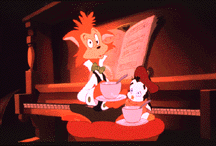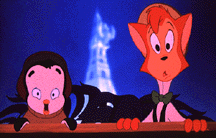Danny the cat.I came to Cats Don't Dance with few expectations, thinking only "a flick with six Randy Newman songs in it can't be all bad." Things got off on the wrong foot with a lifeless, laughless Foghorn Leghorn short, Pullet Surprise (directed by Darrel Van Citters for Chuck Jones Productions) tacked to the beginning, but took a more promising turn as the feature proper got underway. Any movie that borrows successfully from Sunset Boulevard and Singin' in the Rain in the first reel is well on its way to winning this old film buff's heart. Cats...

I came to Cats Don't Dance with few expectations, thinking only "a flick with six Randy Newman songs in it can't be all bad." Things got off on the wrong foot with a lifeless, laughless Foghorn Leghorn short, Pullet Surprise (directed by Darrel Van Citters for Chuck Jones Productions) tacked to the beginning, but took a more promising turn as the feature proper got underway. Any movie that borrows successfully from Sunset Boulevard and Singin' in the Rain in the first reel is well on its way to winning this old film buff's heart. Cats Don't Dance instantly outclasses Warner Bros.' other recent animated release, that merchandising-driven labor-of-lucre, Space Jam. Cats is long on charm--a quality Jam lacked completely. A strong score by Steve Goldstein, with additional tunes and the usual fine lyrics from Hollywood veteran Newman make for a healthy antidote to Jam's cringe-worthy soundtrack. (This reviewer's ears are still ringing, and he continues to ponder a Workman's Comp claim against the makers of that fiasco for cruel and unusual punishment.) Another winning aspect of this animated musical: The plot being about a song-and-dance cat gives its makers the opportunity to create a more dance-driven show than The Little Mermaid, Beauty and the Beast or Hunchback. With elegant choreography supervised by the legendary Gene Kelly, it manages to out-dance recent Disney offerings. Cats draws from both WB animated shorts and MGM movie musicals in their late forties-to-mid-fifties heyday. The look Art Director Brian McEntee has created is refreshingly non-Disney. The stylish Art Deco backgrounds draw on MGM traditions, both animated and live-action. Villainess Darla Dimple looks a bit like Elmer Fudd in drag; while Sawyer resembles the sort of the sophisticated feline Pepé Le Pew might pursue. (The film's best "acting" is by this female catsubtly and expressively animated by Lenny Graves.)

The underlying premise for this musical tale is similar to that found in Who Framed Roger Rabbit, of some Hollywood underclass--in that case Toons, in this case, animal performers. Was Toontown Coontown, the Ink & Paint Club the Cotton Club? Is any particular caste system being suggested here? More like a casting, or type-casting system. The grievance, rather than "no justice for Toons" is "no decent parts for animals"--talent goes unrecognized, careers are stalled. All because of rules like the one that says that cat-actors can only meow onscreen, they're never allowed to sing or dance. The plight of these bit players, who can't get ahead because of studio discrimination, isn't meant to be thought about too hard. It's mainly a pretext for creating an old-fashioned boy-meets-girl, let's put on a show musical. A small-town menagerie bids goodbye to The Boy (Danny the Cat) as he boards a bus for Hollywood. In a flash, he's in the heart of town, dancing across the famous hand prints in front of Graumann's Chinese Theater. His big opening, you-can-do-anything number climaxes with some fancy footwork, inadvertently knocks The Girl (Sawyer the Cat) headfirst into a public fountain. They're both headed for the same place--Farley Wink's talent agency, where they inevitably meet (Girl Hates Boy) and get cast together in the new Darla Dimple musical, Little Ark Angel. At rehearsal, Danny courts disaster by going beyond his only scripted line ("Meow," of course) and upstaging the short-tempered child star. "Max!," screams America's sweetheart at the top of her lungs, and her bodyguard (a big-knuckled, four story tall version of the Eric Von Stroheim character in Sunset Boulevard) instantly appears. Squeezing Danny's slender torso in his giant fist, the monster asks, "What does the Kitty-Kat say?"--"Meow," yelps Danny meekly.

Our Hero is only momentarily dejected, for he soon gets encouragement from little Pudge the Penguin and giant studio mascot Wooly the Mammoth. With Pudge on percussion and Wooly on piano, Danny draws the animal extras into a big musical number in the studio's back alley. As the animals get into the spirit of things, their grayness goes and they take on Technicolor (one of the film's extremely clever palette shifts.) Danny even taunts Sawyer into outdancing him, and we know Boy will (inevitably!) get Girl. Vengeful, crafty Darla invites Danny up to her shocking-pink mansion. Batting her eyelashes coquettishly (savagely chomping heads off of animal crackers all the while), she promises an audition for the animals in front of studio head L.B. Mammoth. She offers free use of the Ark Angel sound stage. Danny, oblivious to her devious behavior, takes the bait. There's another clever palette shift as Darla has a luridly colored fantasy of Danny and Sawyer dancing across a hellish green landscape. Darla arranges a flood reminiscent of Noah's to ruin the animals' big audition, humiliating them in front of L.B., who swears they'll never work in this town again. The animals turn on Danny, who almost heads back to Kokomo, but then gets a last-minute inspiration. His scheme wins the animals' a successful second audition. Darla's frantic attempts to ruin the animals' show only serve to improve it. In an echo of the denouement of Singin' in the Rain, Darla is unmasked as the animal hating little miscreant she is, sinking her career and launching those of Danny and his friends.

Like Broadway's recent Gershwin-crammed hit, Crazy for You, Cats Don't Dance moves along briskly, propelled by show-stopping numbers, obvious plot devices and musical comedy clichés. In this kind of story, predictability becomes an asset. You know what's going to happen but keep watching to see precisely how the makers will contrive to bring it about. If someone took a time machine back to 1955 in order to route an MGM Alan Freed Unit musical through Termite Terrace, the results would look a lot like this. It's a hybrid that never would have occurred to me, but I'm glad first-time director Mark Dindal thought of it, and I hope his unit stays together --they've got a lot of class. I'm curious to see what they'll tackle next. Mark Segall has won awards for labor journalism and public service copywriting. He co-authored How To Make Love To Your Money (Delacorte,1982) with his wife, Margaret Tobin. He is also editor of ASIFA-East's aNYmator newsletter.







